Outforia Quicktake: Key Takeaways
- While several snake species in Tennessee pose little to no threat to humans like Wormsnake and Ring-necked Snake, some dangerous snakes, like the venomous Cottonmouth and Copperhead, pose a threat to humans.
- Tennessee snakes play crucial roles in the ecosystem and can be found in diverse habitats such as hardwood forests, wetlands, and dry sandy regions.
- Snakes in Tennessee have unique characteristics, behaviors, and appearances, helping identify and differentiate them.
- Reptile populations are of growing concern due to habitat changes, stream siltation, and channelization.
Tennessee is home to some amazing things in America. country music, whiskey, great barbecue, and a rich diversity of wild birds, animals and reptiles, including snakes.
Yes, some species of snakes can be dangerous, but that’s not all to them. They play a crucial role in the ecosystem and can even make for good companions. But that’s only when you get over the stigma and understand them better.
In this article, we will describe snake species in Tennessee, let you know what’s unique about them and how to tell them apart.
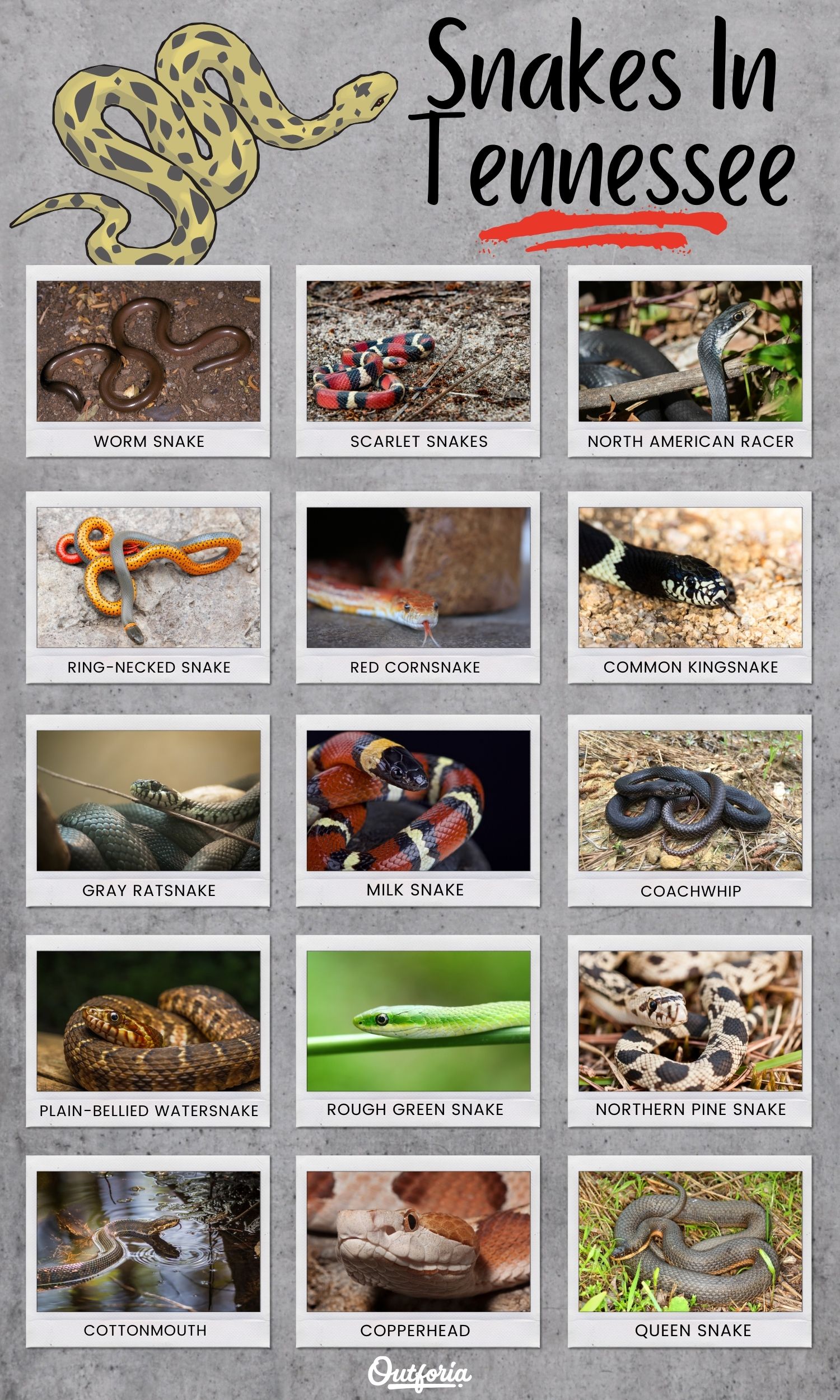
Share This Image On Your Site
<a href="https://outforia.com/snakes-in-tennessee/"><img style="width:100%;" src="https://outforia.com/wp-content/uploads/2022/04/Snakes-in-Tennessee-infographics-03292022.jpg"></a><br>Snakes in Tennessee Infographic by <a href="https://outforia.com">Outforia</a>You May Also Like: Get To Know These 28 Snakes in Colorado complete with Guide, Infographics, Facts, and more!
1. Worm Snake
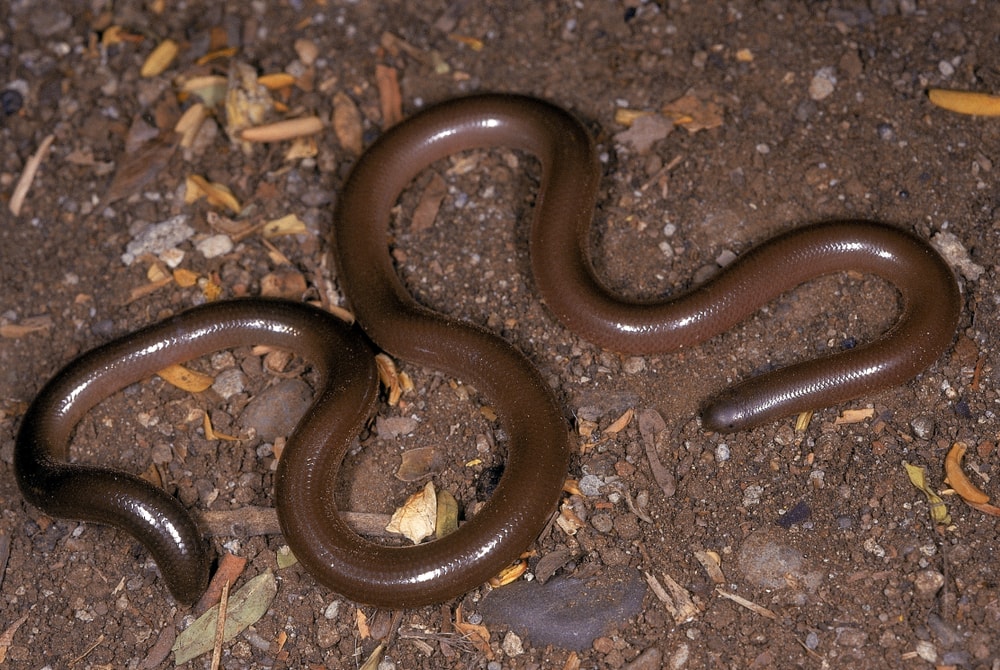
There are two subspecies of Wormsnakes found in Tennessee. The Eastern Wormsnake and the Mideastern Wormsnake. The Eastern is found in the Unaka Mountains while the Mideastern in most areas in the rest of the state.
Wormsnakes, as their name suggests, look like small worms and grow to about 7.5 to 11 inches (19-28cm). They have a small pointy head, a slender body, and a small tail. They are brown on the upper side and pink on the underbelly.
You will mostly find them hiding under moist surfaces like rocks, logs, leaves, and debris in hardwood forests. Their small triangular head is perfect for borrowing, which helps them stay concealed.
The species poses no threat to humans as they dont carry potent venom. Their diet consists of earthworms, insects, and larvae.
Wormsnaks mate during the spring, and the females lay several eggs early in the summer that hatch in late summer early fall.
2. Scarlet Snakes
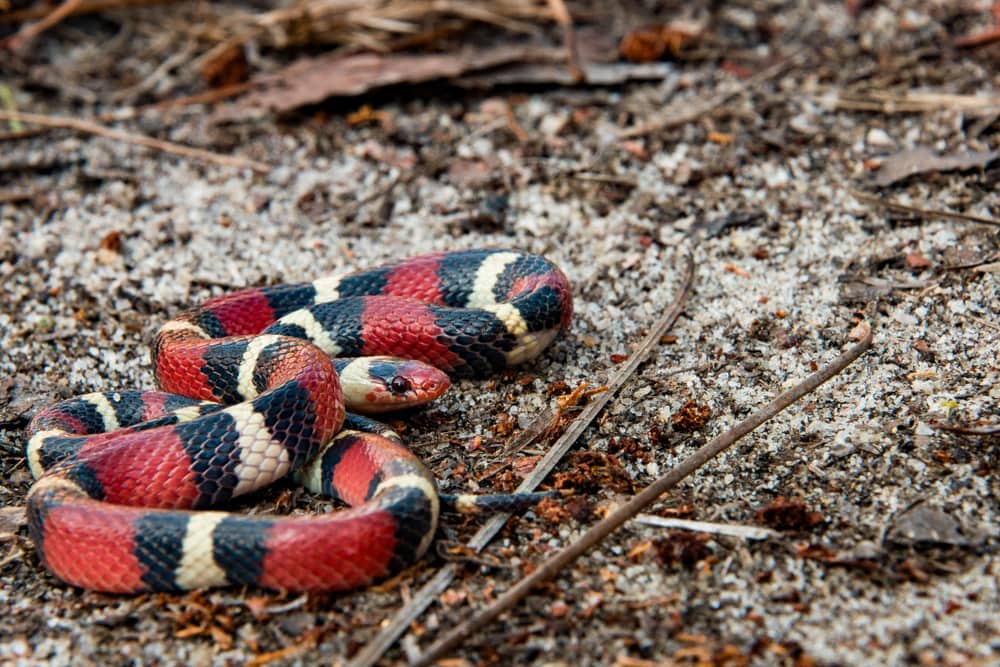
Scarlet snakes are found in most parts of Tennessee except the Northwestern regions. The species are non venomous but frequently confused with venomous coral snakes.
They are medium-sized and grow to about 14 to 20 inches (35-50cm). They are multicolored and possess red, yellow, and black bands over their entire body length. Coupled with their smooth scales, they are something to see. Males are larger than females and have a white underbelly.
They prefer habitats in hardwood forests, loamy cultivated fields, and pinewood forests that are easy to borrow with their pointy heads.
Their diet consists of other snakes, lizards, small mammals, and small reptiles. They also have sharp teeth at the back of their mouths for cracking open eggs too big to swallow whole.
Scarlet snakes mate in spring and lay elongated eggs in early summer that hatch in late summer.
3. North American Racer
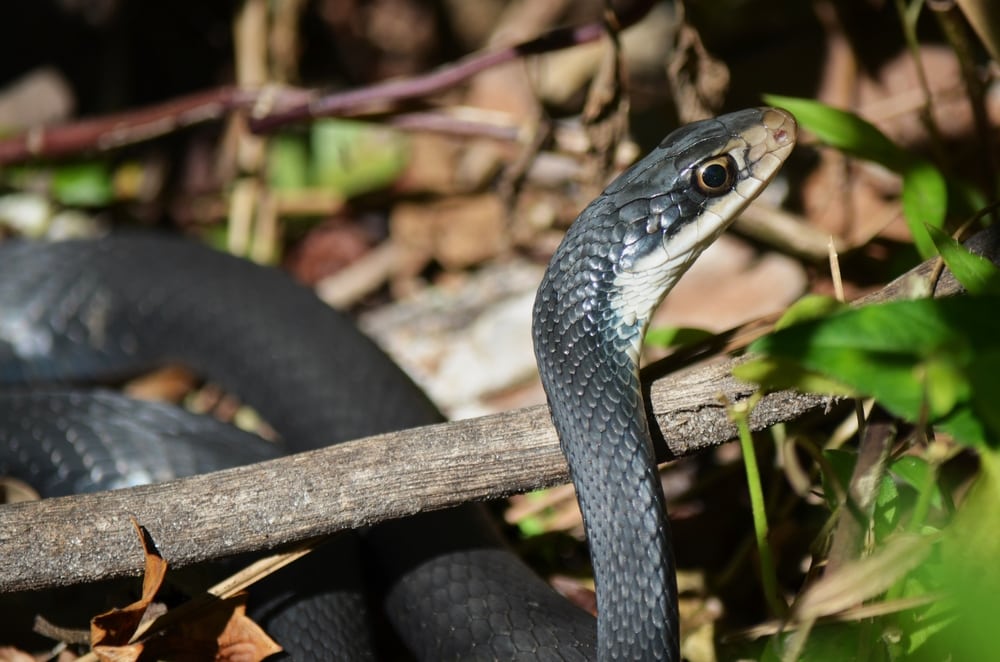
There are two subspecies of the North American Racer found in Tennessee. The Northern Black Racer is present in the East of Tennessee, and the Southern Black Racer found in the state’s Western regions.
They are one of the largest species of snake found in Tennessee and grow to about 36 to 60 inches (91-153cm). The species is primarily black and possesses a white patch on the cheek and throat areas.
Northern American Racers are not known for their speed and agility despite their name. An interesting fact about this snake species in Tennessee is that they use the periscoping hunting technique. This is where they raise their heads to sight their prey before ambushing them.
The species are non venomous and only pack enough juice to stun their prey. They feed on snakes, birds, frogs, and rodents.
The mating season is in spring, and females lay eggs in summer, hatching in late summer and early fall.
4. Ring-necked Snake
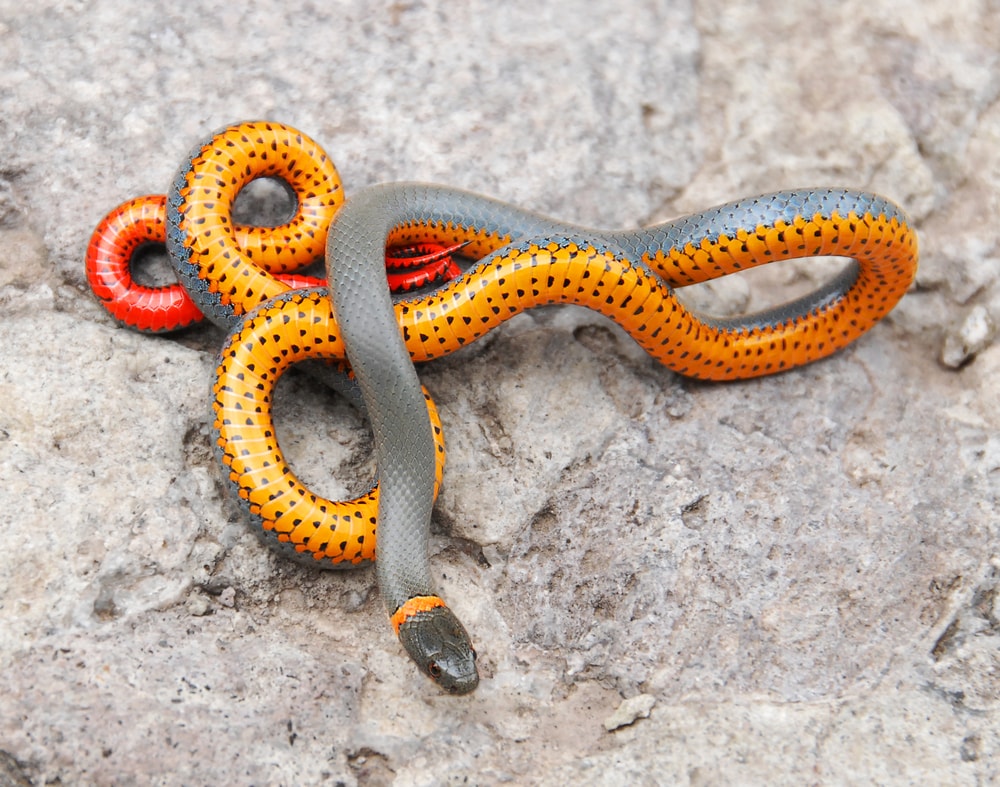
There are two species of the Ring-necked snake found in Tennessee. The Northern Ring-necked snake and the Mississippi Ring-necked snake. They are found in East Tennessee and West Tennessee consecutively.
The Ring-necked snake species are small, slender and can grow to about 10 to 15 inches (25-38cm) long. They have a black or gray hue with an orange or yellow underbelly. They have a distinctive yellow or orange ring around their necks, differentiating them from other Tennessee snake species.
In addition, the Northern Ring-necked snake species have a uniform ring and a plain hue on their bellies to differentiate them further. The Mississippi Ring-necked snake species have an incomplete ring and spots of different hues on their bellies.
They are non venomous and pose a minimum threat to humans.
Ring-necked snakes are also known as “Corkscrew” or “Thimble.” This is because when threatened by predators, they coil around tightly and reveal their colored bellies.
Their diets include small snakes, lizards, earthworms, and larvae.
Mating occurs in spring, and females lay their eggs in the summer, which take seven to eight weeks to hatch.
5. Red Cornsnake
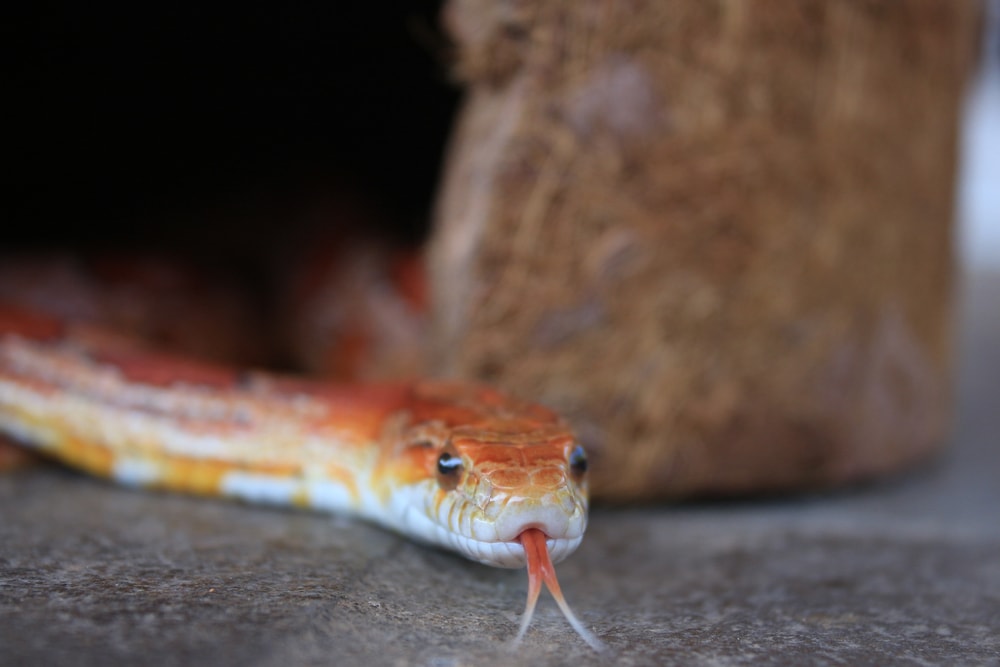
Red Corn Snakes are also called Red Rat snakes. Found in East Tennessee and some parts of the Southwestern. You can find them in different habitats, including rocky hillsides, farmland, and urban areas.
The species are long and slim and grow to be about 30 to 48 inches (76-122cm) long. The snakes have different variations in hues, but most have gray or orange tan and red blotches. Their underbellies have black and white stripes that run to the tail. Young snakes are less brightly colored than adults but get brighter as they grow older.
These are nonvenomous snakes and pose minimal threat to humans.
Red Corn Snakes are nocturnal and most active after the sun goes down. They subdue their prey by constricting and suffocating them before swallowing them whole.
Their diets consist of rodents, frogs, bats, and birds. The mating season is in spring, with females laying eggs in early summer. Young ones emerge in late summer and early fall.
6. Common Kingsnake
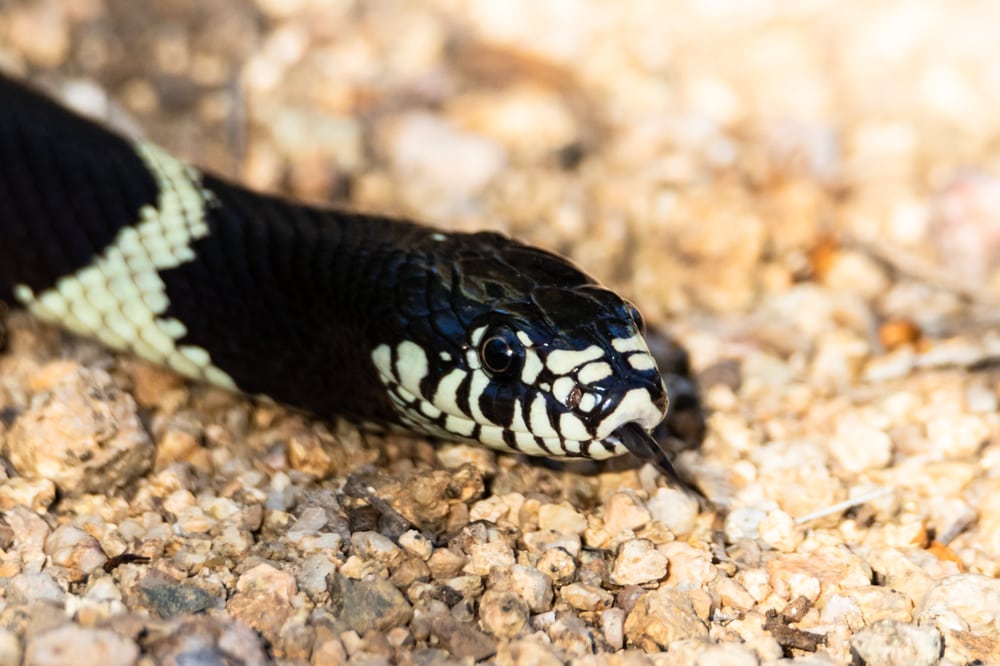
There are three subspecies of the Common Kingsnake in Tennessee. The Eastern Kingsnakes located in the Southeastern parts of Tennessee. The Eastern Black Kingsnakes found throughout Tenessee apart from Northeastern Tennessee. Finally, the Speckled Kingsnake is located in the Western and Southwestern regions of Tennessee.
Unlike their name would suggest, the common Kingsnakes are nothing but common. They are hard to spot and grow to a staggering 36 to 48 inches (98-123cm) long and have one of the best hue profiles of all snake species.
Depending on the subspecies, the snakes are brightly colored with blotches, spots, stripes, and patterns of reds, yellows, black, and white.
You can find the Common Kingsnakes in different habitats, including but not limited to hardwood forests, wetlands, suburbs, and under wood debris.
Their diet consists of rats, rabbits, bird eggs, lizards, and other snakes. They get the name Kingsnakes from their ability to kill other venomous snakes like the rattlesnake and feed on them.
They might be cute, but they are as deadly as snakes come. However, their venom is considered unharmful to humans.
7. Gray Ratsnake
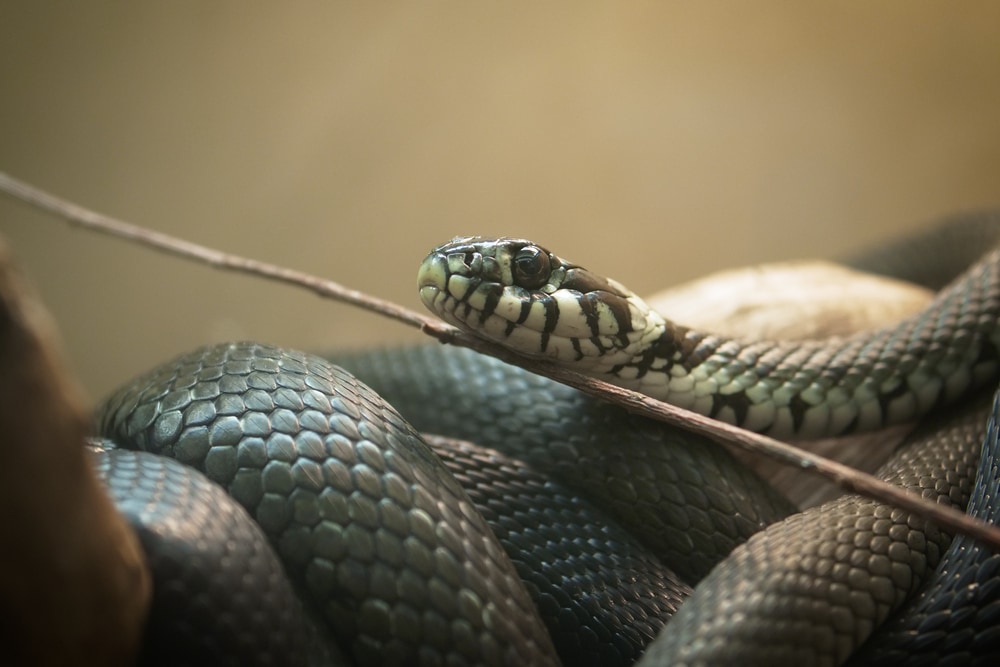
The Gray Ratsnakes, also called Chicken snakes, are found in most parts of Tennessee. You’re most likely to come across them in the barn, farm buildings such as the grain store, and debris around the farm.
They are one of the largest snake species in Tennessee and grow to a whopping 42 to 72 inches (107-183cm). Their dorsal hue is mostly black or gray, with sprinkles of white at the edges of the scales.
Gray Ratsnaks are excellent climbers and are often found in trees busking, or hunting. They are a common species in Tennessee that often gets killed from the fear of snakes. However, they are non venomous and pose no threat to humans.
They play a crucial role in controlling rodent species in the ecosystem and should be let be. Their diet consists of small mammals, birds, and eggs. They suffocate their prey by constricting them and swallowing them whole.
8. Milk Snake
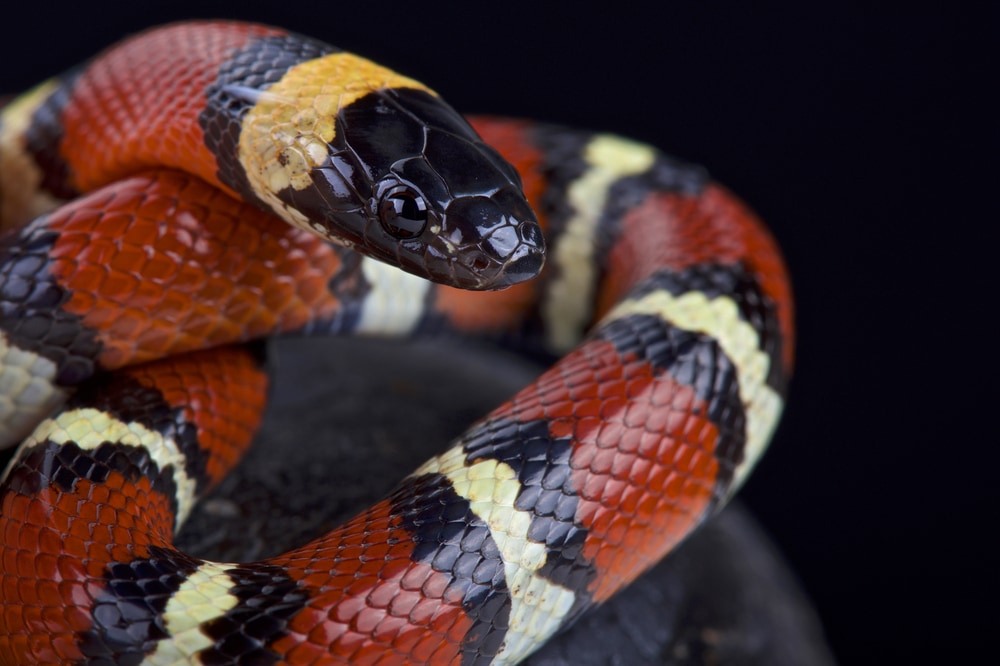
There are three subspecies of the Milk Snake in Tennessee. The Eastern Milk Snakes found in East Tennessee. The Red Milk Snakes found in most regions of West Tennessee, and the Scarlet Kingsnakes found in the South along the Mississippi River.
They are slim, medium-built snakes that grow to about 24 to 36 inches 61-92cm) long. The snake species have a prominent appearance marked by rings of red, black, and white bands that strut their entire bodies.
They are common in hardwood forests, with rocks and boulder shelters to hide in. You can also find them in urban areas, marshes, and savannas.
The name Milksnake comes from the myth that they drink milk from cow’s udders. Obviously, unsubstantiated, but they do feed on other snakes, mice, lizards, and birds.
They breed during spring and lay eggs in early summer that hatch in late summer early fall.
9. Coachwhip
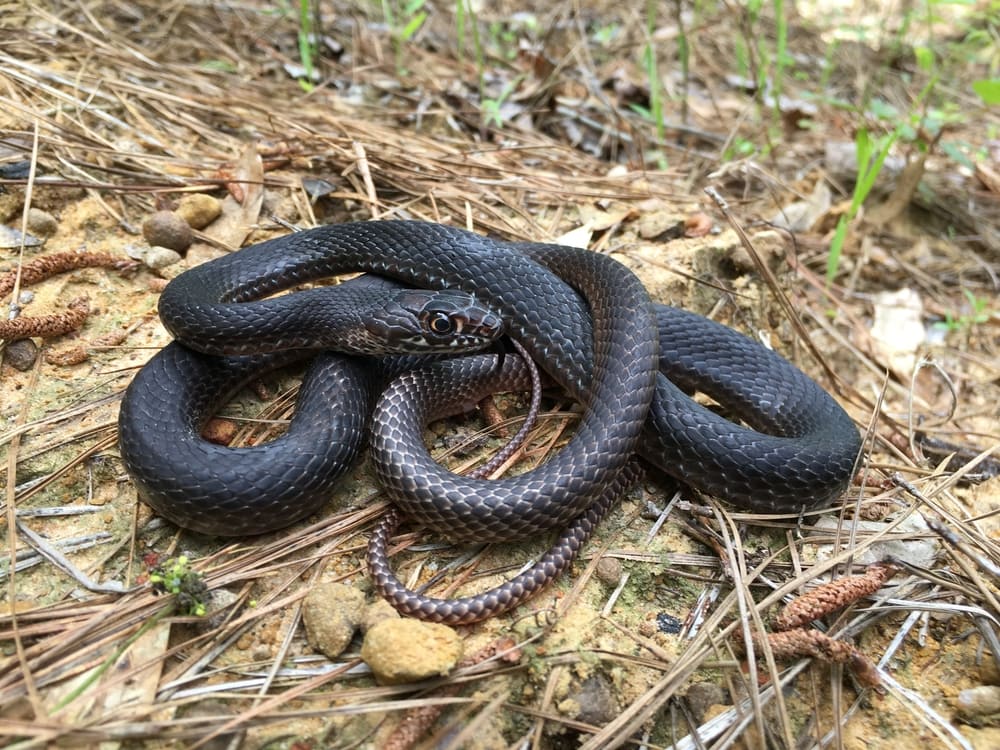
The Eastern Coachwhips are found in the Southwestern regions of Tennessee. They are long slender snakes that look like a whip, hence their name.
They grow to about 46 to 60 inches (116-152cm) long with two distinctive contrasting hues. The upper parts of their bodies are dark and slowly transition to a lighter shade as you move towards the tail. The two-tone is a characteristic of this species and differentiates them from others.
Coachwhips like habitats in dry sandy regions with scrubs, pine woods, and farmland.
Like Racers, they use the periscoping hunting method of lifting their head to spot their prey before ambushing.
Coachwhips are nonvenomous and pose minimum risk to humans. Their diets consist of other snakes, lizards, small mammals, and birds.
Like most other species, their breeding season is spring, and females lay their eggs in summer. Baby snakes emerge from 45 to 85 days.
10. Plain-bellied Watersnake
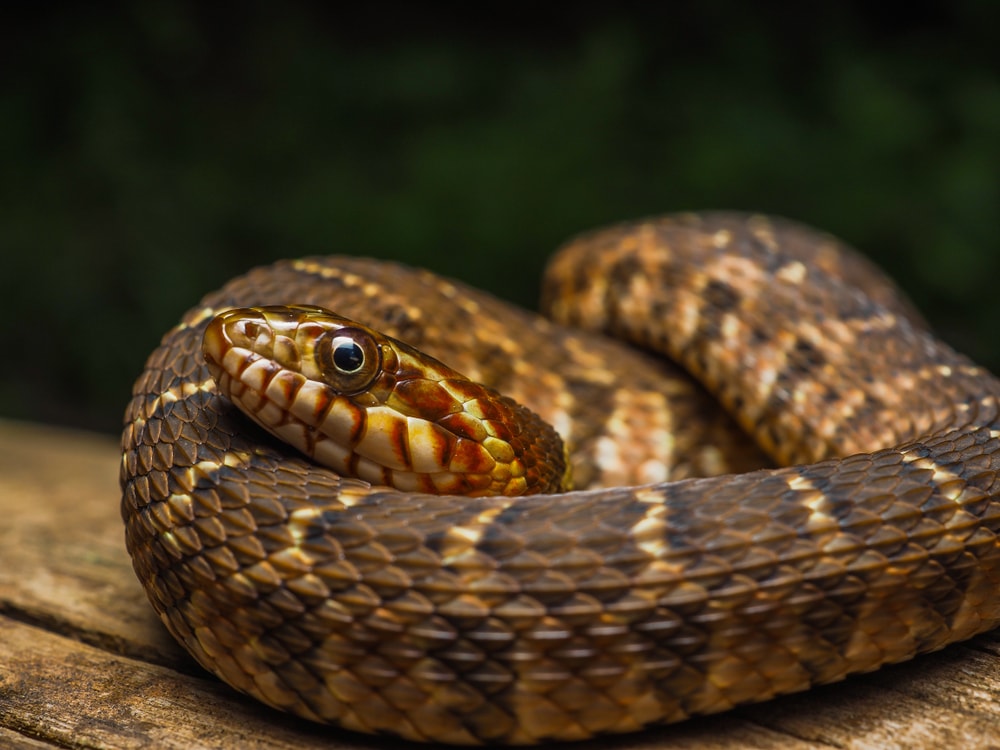
There are two subspecies of the Plain-bellied Watersnake in Tennessee. The Yellow-bellied Watersnake found in south-central and Southern Tennessee. And the Copper-bellied Water Snake found in the Cumberland and Tennessee River watersheds in middle-Tennessee.
The girthy snakes can grow to about 30 to 48 inches (76-121cm) long. Young Plain-bellied Water Snakes have bold patterns on their backs that gradually disappear as the snake matures. In adulthood, the snakes are reddish-brown with a greenish underbelly.
They are non venomous and pose no threat to humans, but they are commonly mistaken for venomous Cottonmouths and killed.
Unlike most watersnakes, Plain-bellied Water Snakes run for land and not water whenever threatened by predators. Curious for a watersnake.
The species is rare, and only small numbers exist in Tennessee. This has led to their status as most concern, and they are under protection by the Tennessee Department of Environment.
11. Rough Green Snake
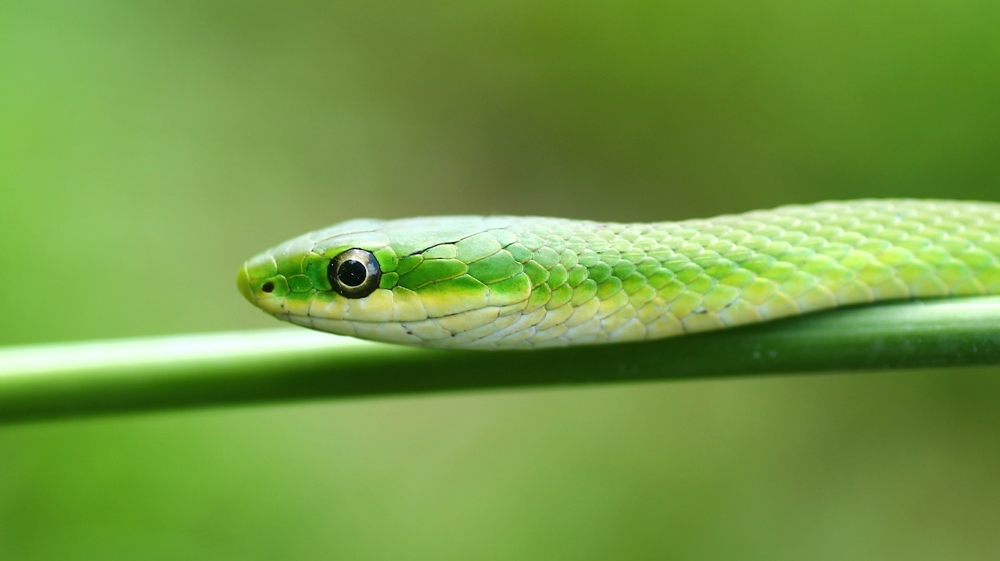
The Rough Green snakes, also called Vine snakes, are found in most parts of Tennessee except the Northerneastern.
The slender green snakes can grow to about 22 to 32 inches (55-82cm) long. They have keeled scales and white or yellowish bellies. Young snakes are grayish but turn green as they age. Males are differentiated from females by their long tails.
Rough Green snakes spend most of their time climbing in vegetation near water sources.
An interesting fact about this species is that they turn to a paler blue or back that resembles Black Racers after death.
They are nonvenomous, and their diet consists of spiders, grasshoppers, and caterpillars.
The breeding season is in spring, and females lay eggs in a community nest in summer. The eggs take about 36 to 43 days to hatch, and the females may use the same nest for generations of snakes.
12. Northern Pine Snake
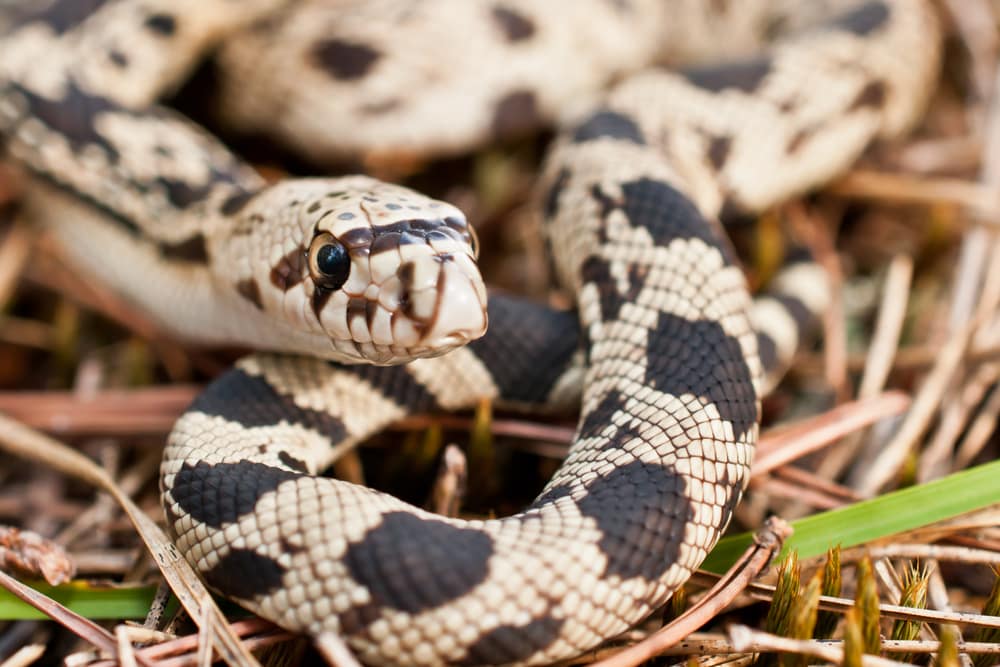
The Northern Pine snakes are found in most Tennessee regions except for a handful of places.
One of the largest snake species found in Tennessee, the Northern Pines, can grow to 48 to 66 inches (121-168cm) long. Their scales are keeled and have four distinctive prefrontal scales in front of their eyes.
Their heads are also very distinctive because they’re shaped like turtles’ heads. This is because of their small heads compared to their body ratios.
Northern Pine snakes hibernate underground during the winter in communities of few snakes and emerge in April.
When predators threaten Northern Pine snakes, they inflate their bodies to look larger, make a hissing noise, and vibrate their tails. They also strike at the threat with the mouth closed because they mostly don’t bite.
They are non venomous and pose minimal danger to humans.
The species also have the largest eggs of any snake species in Tennessee and Northern America.
13. Cottonmouth
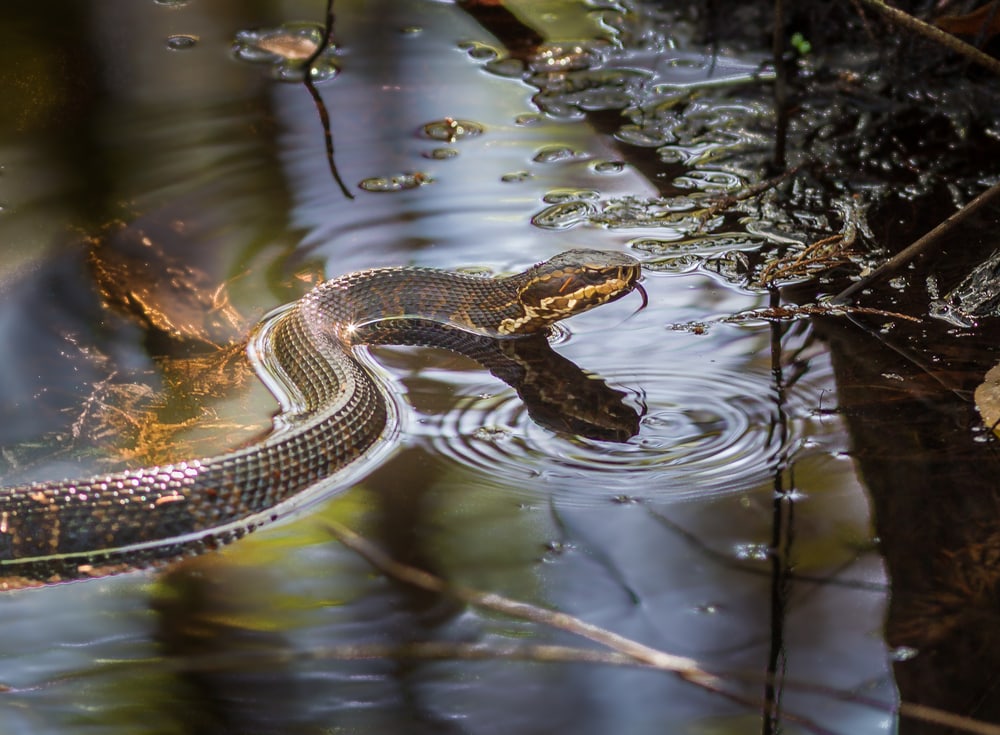
Cottonmouths, also known as Water Moccasins, are semi-aquatic venomous species found in West Tennessee.
These large, heavy-bodied snakes grow to about 30 to 42 inches (76-107cm) long. They have triangular heads, keeled scales, and are olive-brown. Their underbellies are tan or gray and dark blotches.
Male Cottonmouths are larger and heavier than females. The species’ aggressiveness may be a little overhyped because they are not confrontational. When encountered, they try to escape in random directions and can surge towards you even though they meant to run away. Adding to the hysteria, which in this case is a good thing because they are highly venomous.
Their name cottonmouth comes from one of their characteristics. When confronted, they tend to open their mouths, revealing a white cotton-like interior.
The species can be active during the day or night but mainly forages at night in cooler temperatures.
Their diet consists of fish, rodents, snakes, lizards, and frogs.
14. Copperhead
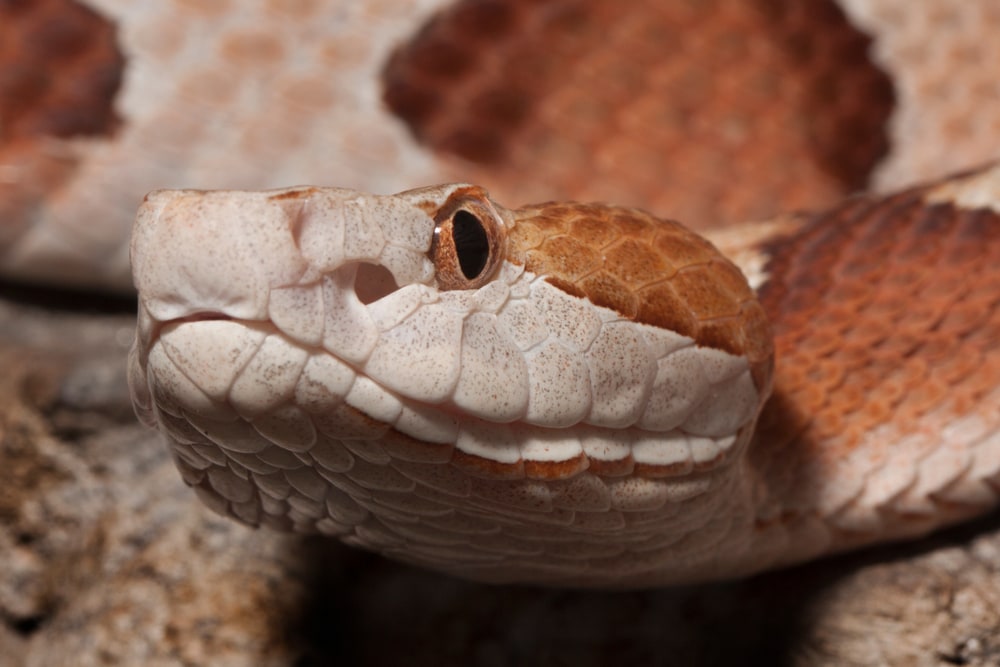
There are two subspecies of the Copprheads in Tennessee. The Southern Copperhead found in West Tennessee, and Northern Copperhead found throughout the state.
These pit vipers are relatively large and can grow to about 24 to 36 inches (61-92cm) long. They have a big triangular head that is copper dotted with vertical pupils.
They have very distinctive hourglass brown patterns on their bodies contrasted by a brown hue.
Copperheads prefer rocky hillsides with cover from dense vegetation and forests. However, you can also find them in urban and suburban areas.
Even though Copperheads are venomous, a bite from one is not lethal but will nonetheless give you quite the fright.
15. Queen Snake
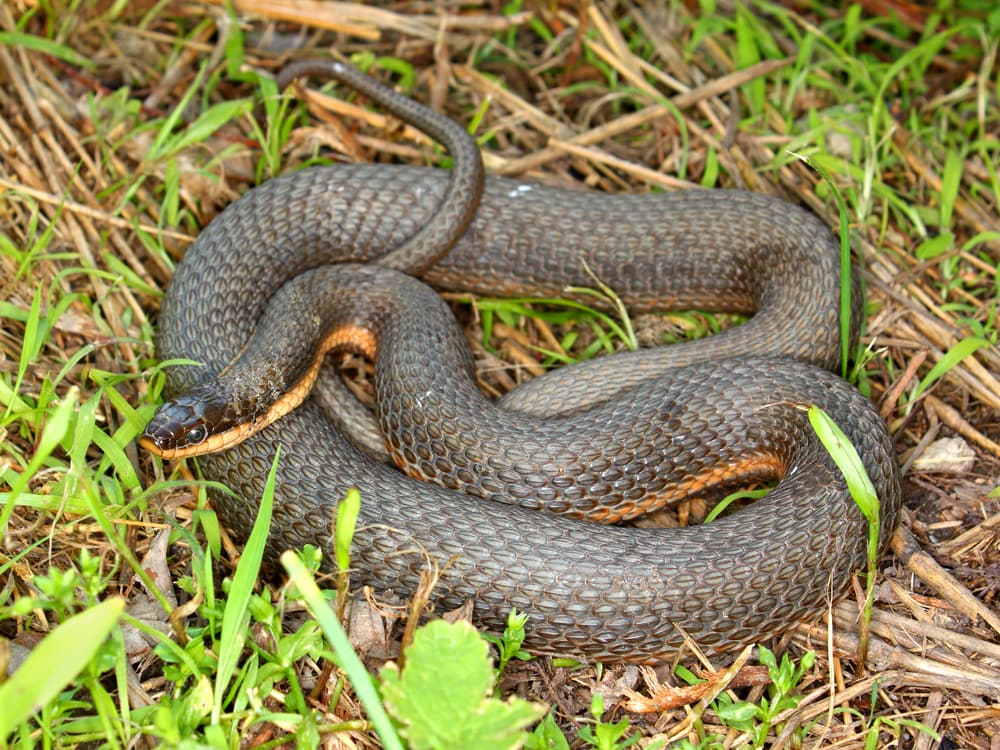
Queen snakes are also called Willow snakes or Lethal snakes. Found in Mid and East Tennessee.
Queen snakes are medium-sized aquatic species that grow to about 15 to 24 inches (38-61cm) long. They have keeled scales and gray bodies with light black stripes running down the sides.
Their habitats are mostly cool rivers in rocky areas. You will find them basking on rocks or perched on vegetation near running water.
Their population in Tennessee is high, but the concern is rising from stream siltation and channelization.
Their diet is almost exclusively composed of young crayfish, but they’re also known to feed on tadpoles.
Queen snakes’ breeding season is in spring, and they give birth to young ones in summer through fall.








